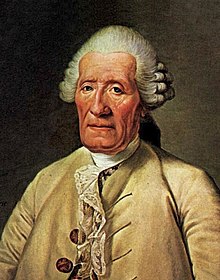Jacques de Vaucanson
Jacques de Vaucanson | |
|---|---|
 Portrait by Joseph Boze, c. 1784 | |
| Born | Jacques Vaucanson February 24, 1709 Grenoble, France |
| Died | November 21, 1782 (aged 73) Paris, France |
| Education | Jesuit school in Grenoble (now Lycée Stendhal) |
| Occupations |
|
| Known for | Building first all-metal lathe, Designing the first automatic loom, and Automata |
| Spouse | Madeleine Rey |
| Children | 1 |
Jacques de Vaucanson (French:
Early life
De Vaucanson was born in
Automaton inventor

At just 18 years of age, Vaucanson was given his own workshop in Lyon, and a grant from a nobleman to construct a set of machines. In that same year of 1727, there was a visit from one of the governing heads of
In 1737, Vaucanson built The Flute Player, a life-size figure of a shepherd that played the tabor and the pipe and had a repertoire of twelve songs. The figure's fingers were not pliable enough to play the flute correctly, so Vaucanson had to glove the creation in skin. The following year, in early 1738, he presented his creation to the Académie des Sciences.[7]
Johann Joachim Quantz, court musician and long-time flute instructor to Frederick II of Prussia, discussed the shortcomings of Vaucanson's mechanical flute player. In particular its inability to sufficiently move the lips resulted in the necessity of increasing the wind pressure for the upper octaves. Quantz discouraged this method as producing a shrill, unpleasant tone.[8]
At the time, mechanical creatures were somewhat a fad in Europe, but most could be classified as toys, and de Vaucanson's creations were recognized as being revolutionary in their mechanical lifelike sophistication.
Later that year, he created two additional automata, The Tambourine Player and The Digesting Duck, which is considered his masterpiece. The duck had over 400 moving parts in each wing alone, and could flap its wings, drink water, seemingly digest grain, and seemingly defecate.[7] Although Vaucanson's duck supposedly demonstrated digestion accurately, his duck actually contained a hidden compartment of "digested food", so that what the duck defecated was not the same as what it ate; the duck would eat a mixture of water and seed and excrete a mixture of bread crumbs and green dye that appeared to the onlooker indistinguishable from real excrement. Although such frauds were sometimes controversial, they were common enough because such scientific demonstrations needed to entertain the wealthy and powerful to attract their patronage. Vaucanson is credited as having invented the world's first flexible rubber tube while in the process of building the duck's intestines. Despite the revolutionary nature of his automata, he is said to have tired quickly of his creations and sold them in 1743.
His inventions brought him to the attention of
Government service

In 1741 de Vaucanson was appointed by
In 1746, he was made a member of the Académie des Sciences.[12]
Lathe
In 1760 he invented the first industrial metal cutting
Legacy
Jacques de Vaucanson died in Paris in 1782. Vaucanson left a collection of his work as a bequest to
Vaucanson’s proposals for the automation of the weaving process, although ignored during his lifetime, were later perfected and implemented by
Lycee Vaucanson in Grenoble is named in his honor, and trains students for careers in engineering and technical fields.
See also
References
- ^ Jacques de Vaucanson at the Encyclopædia Britannica
- ISBN 978-9380578576.
- ^ a b Account by Christiane Lagarrigue
- ^ Mahistre, Didier. "Jacques de Vaucanson". Archived from the original on 2004-06-12. Retrieved 2020-02-21.
- ^ "Jacques de Vaucanson (1709-1782)". Archived from the original on 2004-03-06. Retrieved 2004-01-17.
- ^ Wood, Gabby. "Living Dolls: A Magical History Of The Quest For Mechanical Life", The Guardian, 2002-02-16.
- ^ a b SCHMIDT, PETER. "on Jacques de Vaucanson and his Duck". Swarthmore College. Archived from the original on 2017-07-02. Retrieved 2004-01-15.
- ^ Quantz, Johann Joachim (1752). Versuch einer Anweisung die Flöte traversiere zu spielen [Attempt at instruction in playing the transverse flute] (in German). Berlin, (Germany): Johann Friedrich Voß. p. 46. Available at: Deutsches Text Archiv
- ^ Otto Lueger (Hrsg): Lexikon der gesamten Technik und ihrer Hilfswissenschaften. Bd. 5, S. 452, Zweite, vollständig neu bearbeitete Auflage, Deutsche Verlags-Anstalt Stuttgart, Lei
- ^ Chronology of Lyon
- ^ Gaby Wood (2002). Edison's Eve. Alfred A. Knopf, New York.
- ^ Biography at Vaucanson.org (fr) Archived 2003-12-20 at the Wayback Machine
- S2CID 111617989.
- ).
- ^ "Metal-turning lathe – Jacques Vaucanson".
- ^ "Tour à charioter de Vaucanson".
- ^ T.K. Derry & Trevor I. Williams (1960). A Short History of Technology.
- ^ a b Wang, Yanyu (2020). "Jacques de Vaucanson (1709–1782)". In Ceccarelli, Marco; Fang, Yibing (eds.). Distinguished Figures in Mechanism and Machine Science: Their Contributions and Legacies, Part 4. New York: Springer. pp. 15–46.
- ISBN 978-9081956888.
